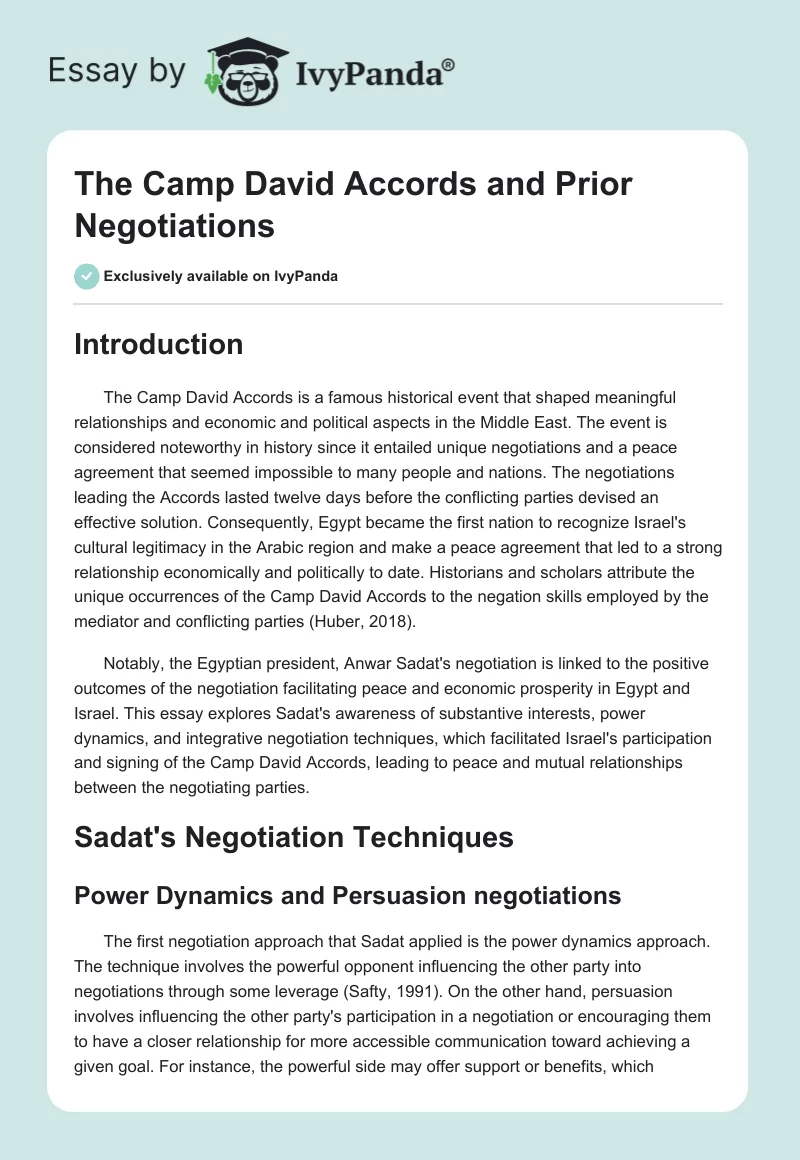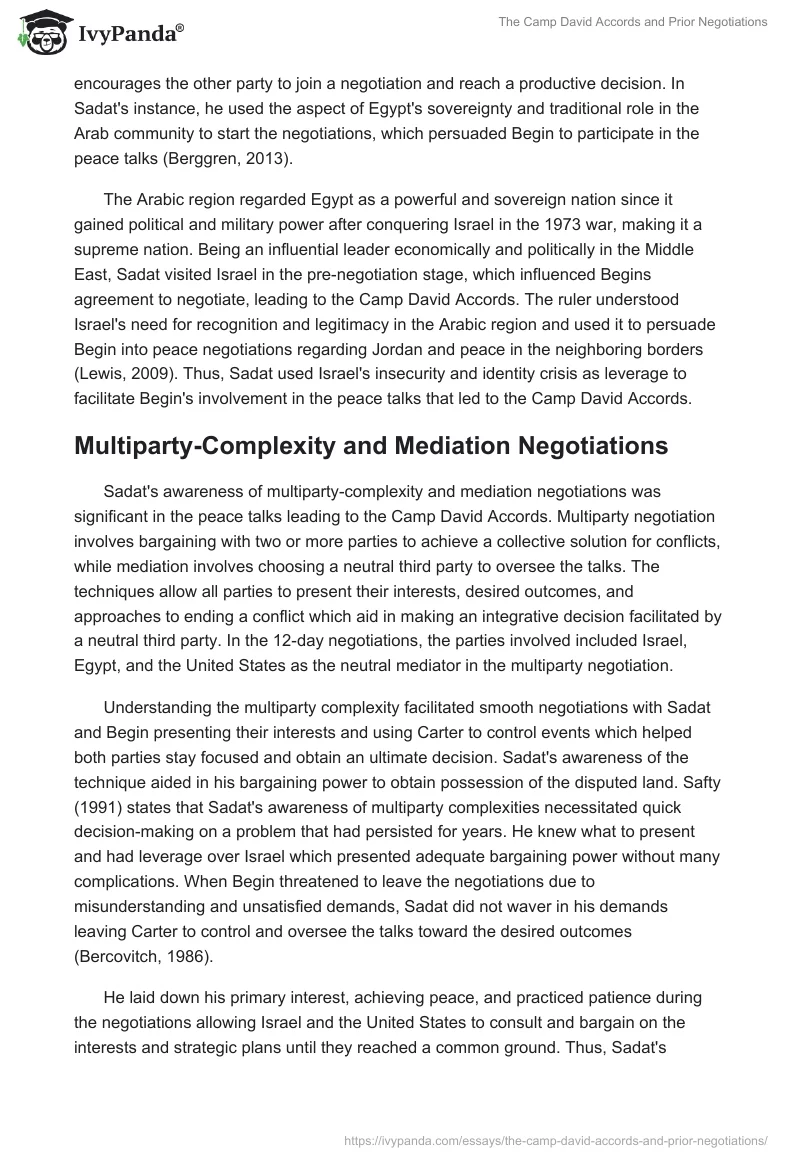Introduction
The Camp David Accords is a famous historical event that shaped meaningful relationships and economic and political aspects in the Middle East. The event is considered noteworthy in history since it entailed unique negotiations and a peace agreement that seemed impossible to many people and nations. The negotiations leading the Accords lasted twelve days before the conflicting parties devised an effective solution. Consequently, Egypt became the first nation to recognize Israel’s cultural legitimacy in the Arabic region and make a peace agreement that led to a strong relationship economically and politically to date. Historians and scholars attribute the unique occurrences of the Camp David Accords to the negation skills employed by the mediator and conflicting parties (Huber, 2018).
Notably, the Egyptian president, Anwar Sadat’s negotiation is linked to the positive outcomes of the negotiation facilitating peace and economic prosperity in Egypt and Israel. This essay explores Sadat’s awareness of substantive interests, power dynamics, and integrative negotiation techniques, which facilitated Israel’s participation and signing of the Camp David Accords, leading to peace and mutual relationships between the negotiating parties.
Sadat’s Negotiation Techniques
Power Dynamics and Persuasion negotiations
The first negotiation approach that Sadat applied is the power dynamics approach. The technique involves the powerful opponent influencing the other party into negotiations through some leverage (Safty, 1991). On the other hand, persuasion involves influencing the other party’s participation in a negotiation or encouraging them to have a closer relationship for more accessible communication toward achieving a given goal. For instance, the powerful side may offer support or benefits, which encourages the other party to join a negotiation and reach a productive decision. In Sadat’s instance, he used the aspect of Egypt’s sovereignty and traditional role in the Arab community to start the negotiations, which persuaded Begin to participate in the peace talks (Berggren, 2013).
The Arabic region regarded Egypt as a powerful and sovereign nation since it gained political and military power after conquering Israel in the 1973 war, making it a supreme nation. Being an influential leader economically and politically in the Middle East, Sadat visited Israel in the pre-negotiation stage, which influenced Begins agreement to negotiate, leading to the Camp David Accords. The ruler understood Israel’s need for recognition and legitimacy in the Arabic region and used it to persuade Begin into peace negotiations regarding Jordan and peace in the neighboring borders (Lewis, 2009). Thus, Sadat used Israel’s insecurity and identity crisis as leverage to facilitate Begin’s involvement in the peace talks that led to the Camp David Accords.
Multiparty-Complexity and Mediation Negotiations
Sadat’s awareness of multiparty-complexity and mediation negotiations was significant in the peace talks leading to the Camp David Accords. Multiparty negotiation involves bargaining with two or more parties to achieve a collective solution for conflicts, while mediation involves choosing a neutral third party to oversee the talks. The techniques allow all parties to present their interests, desired outcomes, and approaches to ending a conflict which aid in making an integrative decision facilitated by a neutral third party. In the 12-day negotiations, the parties involved included Israel, Egypt, and the United States as the neutral mediator in the multiparty negotiation.
Understanding the multiparty complexity facilitated smooth negotiations with Sadat and Begin presenting their interests and using Carter to control events which helped both parties stay focused and obtain an ultimate decision. Sadat’s awareness of the technique aided in his bargaining power to obtain possession of the disputed land. Safty (1991) states that Sadat’s awareness of multiparty complexities necessitated quick decision-making on a problem that had persisted for years. He knew what to present and had leverage over Israel which presented adequate bargaining power without many complications. When Begin threatened to leave the negotiations due to misunderstanding and unsatisfied demands, Sadat did not waver in his demands leaving Carter to control and oversee the talks toward the desired outcomes (Bercovitch, 1986).
He laid down his primary interest, achieving peace, and practiced patience during the negotiations allowing Israel and the United States to consult and bargain on the interests and strategic plans until they reached a common ground. Thus, Sadat’s awareness of mediation and multiparty-complexity resulted in the signing of the Camp David Accords, creating a lasting and unique solution between the two nations.
Cultural and Ethical Considerations
Culture is essential during negotiations affecting populations with the same cultural ideas. Sadat was aware of the Arabic nations’ culture and pride, which made them reluctant to make regional peace, particularly with the Israelites. Sadat used the Arabic culture’s union, and both countries’ cultural benefits would be achieved in the event of peace in the region. Cultural considerations in the Camp David Accords negotiations included Israelite’s right to legitimacy as an Arabic nation (Bercovitch, 1986). Hence, Sadat offered peace talks to sustain Israelite culture by being allies with Egypt.
At the same time, Israel and Arabic leaders believed no Arabic leader would ever visit Israel individually since they were alienated from the Arabic regions. Therefore, he applied the ethical considerations of negotiation by agreeing to fair talks and distributing the conflicted cultural resources (Camp David Accords, 1978). Sadat’s approach to persuading Begin was straightforward and honest from the beginning, which conforms to the negotiation ethic that promotes justice and successful negotiations.
ZOPA and BATNA Negotiations
Sadat applied the ZOPA (Zone of Possible Agreement) negotiation technique over the BATNA (Best Alternative to a Negotiated Agreement) negotiations to achieve peace between Israel and Egypt. ZOPA negotiation involves finding common ground that satisfies both parties through concessions and exchange, while BATNA negotiation involves a party having other options if the agreement fails, which can be advantageous to the other party.
According to Cohen-Almagor (2019), Sadat’s primary goal was peace and he willingly made numerous concessions to reach a ZOPA. When Kissinger presented Israel’s demands to exchange prisoners and end Egypt’s blockade at Bab El-Mandeb in exchange for returning the October 22′ line, Sadat accepted without any argument (Safty, 1991). The move astonished Kissinger since he expected Sadat to offer another alternative leading to BATNA negotiations. However, Sadat aimed to achieve substantive peace instead of arguing over alternatives that would cause more conflicts. Therefore, the agreement reached a ZOPA point, with both parties agreeing to the stated terms, which led to the signing of the Camp David Accords.
Relationship and Substantive Interests Negotiation
Another strategy Sadat employed in the negotiation was the interest-based or substantive interest approach. The approach involves satisfying both parties through substantive exchanges such as property and hostages, which can create mutual relationships and benefits. The relationship negotiation may foster mutual connections psychologically, politically, or economically (Eyal, 2019). The peace agreement meant receiving foreign aid from the West, strengthening both countries’ military might and political and economic sovereignty (Camp David Accords, 1978).
As a substantive negotiator, the offer served his interests, leading to concessions to benefit Egypt’s economic and political stability. Although Egypt had supreme power in the Middle East before the Camp David Accord, Sadat knew that the sovereignty was at risk of collapsing due to Egypt’s rapid population growth. The country needed foreign assistance to support its military, social and political status, which could be achieved by signing the accord and maintaining peace. The alternative of peace, which is going into war, would ruin Egypt’s economy and political power leading to less prestige and power among the Arabic nations (Kramer, 2017).
Further, both countries would create excellent and strong relationships between themselves and the United States, which had added advantages in foreign trade and receiving foreign aid (Wallensteen, 2018). Therefore, the negotiation led to a relationship and substantive interests where both parties benefitted from choosing to end conflicts in the middle east which has extended to date in the region.
Integrative and Distributive Negotiation
The technique refers to making negotiations as joint partners towards a common ground that serves the interest of both parties. In that case, both parties identify their interest in the negotiation and make concessions until they achieve optimum results that satisfy each party’s needs by distributing resources jointly. Thus, the negotiation leads to an integrative solution where both parties win peacefully, combining and sharing disputed concerns (Mahmood, 1985).
In the Camp David negotiations, Sadat was aware of Israel’s interests in the conflict which he presented to allow an integrative negotiation. He proposed peace between Egypt and Israel to end the war and reclaim Egypt’s legitimacy in the Middle East since Begin’s interest lay in recognition as the Arabic nation. In turn, Sadat’s objective was to reclaim Sinai and maintain Egypt’s supremacy economically, culturally, and politically. If they reached a ZOPA, both countries would benefit from the peace agreement where Israel’s cultural and religious identity would be recognized, and Egypt would reclaim their religious and cultural recognition, which was the land under dispute.
Offering peace in the interest of both parties was distributive since both parties would end up with significant benefits. Whereases Egypt would maintain its supremacy and obtain the disputed lands, Israel reestablished its legacy and security in the Arabic regions leading to a win-win situation (Camp David Accords, 1978). Consequently, maintaining peace with Israel guaranteed the war’s end in the Arabic region since it gave Israel and Egypt power over other nations, making them untouchable (Bercovitch, 1986).
With their unity in military, political, and economic resources, other Arabic nations could not match their strength if they resorted to war. Thus, the camp David accord led to good integrative and distributive interests in foreign trade and security exchanges between Israel, the United States, and Egypt since Egypt was the first country to make peace with Israel.
Conclusion
Sadat facilitated effective negotiations through his awareness of constructive negotiating skills. His willingness to achieve peace between Israel and Egypt is evident in his strategic negotiation skills. The ruler wanted peace for economic, political, and socio-cultural prosperity among his people, Israel, and the entire Arabic region. Hence, he used Egypt’s superiority and influence to sway Begin’s participation and decision-making. Although influential rulers tend to exploit others to gain personal interests in a negotiation, Sadat used his power to make concessions and risky measures which led to peace. He advocated for substantive interest and integrative benefits, cultural and ethical considerations, BATNA and ZOPA negotiations, multiparty complexities, mediation, persuasion, and distributive interests, which have led to Egypt and Israel’s relationship and economic and socio-cultural prosperity.
References
Bercovitch Jacob. 1986. “A Case Study of Mediation as a Method of International Conflict Resolution: The Camp David Experience.” Review of International Studies 12 (1): 1 43–65. Web.
Berggren, Jackson D. 2013. “Carter, Sadat, and Begin: Using Evangelical-Style Presidential Diplomacy in the Middle East.” Journal of Church and State 56 (4): 732–56. Web.
Cohen-Almagor, Raphael. 2019. “Lessons from the Israeli-Egyptian Peace Talks.” Israel Studies Review 34 (2): 1–32. Web.
Eyal, Lewin. 2019. “Book Review: Gerald M. Steinberg and Ziv Rubinovitz – Menachem Begin and the Israel-Egypt Peace Process: Between Ideology and Political Realism.” National Resilience, Politics, and Society, (1): 259–63. Web.
Huber, Daniela. 2018 (Rep). Forty Years of Camp David, Forty Years Without Peace. Rome, Italy: Instituto Affari Internazionali.
Kramer, Martin. 2017. “Sadat and Begin: The Peacemakers.” The War on Error, 125–31. Web.
Lewis, Samuel W. 1988. “The Legacy of Camp David for Future Peacemakers.” Harvard International Review 11 (1): 4–5. Web.
Lewis, Samuel. 2009. (Rep). The Legacy of Camp David: 1979-2009. Washington DC: Middle East Institute.
Mahmood, Zahid. 1985. “Sadat and Camp David Reappraised.” Journal of Palestine Studies 15 (1): 62–87. Web.
Safty, Adel. 1991. “Sadat’s Negotiations with the United States and Israel.” American Journal of Economics and Sociology 50 (4): 473–84. Web.
“The Camp David Accords. Framework for peace in the Middle East agreed at Camp David”. Treaty Series: Treaties and International Agreements Registered and Filed by The Secretariat of The United Nations 1138, no. 17853 (1978): 40-45.
Wallensteen, Peter. 2018. Understanding Conflict Resolution. S.l.: Sage Publications. 1-256.
Winter, Ofir, and Udi Dekel. 2019 (Rep). Egypt and Israel: From Peace between Leaders and Armies to Peace between Peoples. Tel Aviv, Israel: Institute for National Security Studies.


